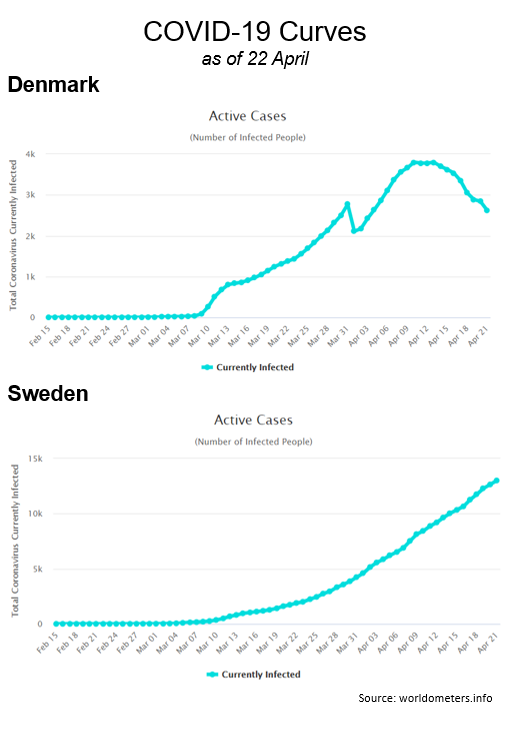The Nordic Divide on Fighting COVID-19: Why are Denmark and Sweden Taking Drastically Different Approaches?
Differences provide window of insight into populations and nuances across Scandinavia

To outsiders, Denmark and Sweden are often seen as one in the same due in large part to their cultural similarities and geographic proximity. After all, in approximately ten minutes you can drive from Denmark to Sweden by crossing the famous Øresund Bridge. That said, the stark contrast in how these countries are working to contain the spread of COVID-19 has baffled experts around the world.
Unlike Denmark, which has placed lockdown restrictions similar to the rest of the world, Sweden has not closed its borders, public schools, or non-essential businesses. As noted in a recent New York Times report, “Sweden’s approach has raised questions about whether it’s gambling with a disease.” Why then are two seemingly similar countries taking vastly different approaches towards battling this pandemic, and which strategies appear to be the most effective thus far? Further, what can we as healthcare-focused communications, marketing and public affairs practitioners learn going forward?
Neighbors, but Opposite COVID-19 Approaches
Like Denmark and most countries across the globe, Sweden’s health officials have stressed safe hygiene practices, social distancing, and protecting older and vulnerable citizens. However, in Sweden, restaurants, playgrounds, gyms, malls, and most schools remain open (except for high schools, colleges and universities). Why is this the case?
One explanation comes from one of Sweden’s epidemiologists, who commented that “Sweden’s approach appeals to the public’s self-restraint and sense of responsibility. Our whole system for communicable disease control is based on voluntary action.”
In contrast, in Denmark all borders are closed, (except e.g. for workers commuting between the two countries) all non-essential public employees have been sent home with full pay, gatherings of more than 10 people are prohibited, and all schools were closed for five weeks. Most recently, Denmark has re-opened school and day care services for young children.
Additional reasons why these countries have taken different routes in containing the spread of COVID-19 also stem from geographic, demographic, environmental and governmental differences between Denmark and Sweden:
- Size and population density: Sweden is approximately ten times larger in area than Denmark but only has 50 % more inhabitants. Therefore, while Denmark contains 136 inhabitants per square kilometer, Sweden only has 25 inhabitants per square kilometer. That could, in theory, make it harder for the virus to spread in Sweden than in Denmark.
- Single vs. multi-generational households: Sweden has the highest number of single households in the world. Elsewhere in Europe, several generations of families live together, or younger people find it too expensive to live alone.
- Holiday travel habits: In February, many Danes flocked to the ski slopes in Austria for winter holidays, despite its proximity to Italy where a known outbreak was occurring. On the other hand, many Swedes remained in Sweden to ski during their winter break.
- Public authorities: The less radical measures taken against the virus in Sweden can be an expression of a more rational and scientific management of the crisis than in Denmark. The Swedish public authorities are empowered to make their strategy more guided by scientific reasons than by political considerations.
In both nations, hospitals are challenged but not overwhelmed, and neither has experienced the severe lack of personal protective equipment (PPE) that has been seen in the United States and elsewhere. As of 22 April, Sweden had reported 1,937 COVID-19 deaths from 16,004 cases (a roughly 12% fatality rate), while Denmark recorded 394 fatalities from 7,912 cases (4.8% death rate based on Johns Hopkins University statistics).
While Swedish officials do speak of a flattening of their curve due to its unique approach, the number of active cases remains on an upward trajectory. This contrasts with Denmark; whose curve is clearly in a downward trend.
We cannot definitively say that Sweden’s continued rise in cases was caused directly by its unique approach to coronavirus response. However, it is certain that here in Denmark, despite being a much more densely populated country with a smaller land mass, our authorities’ response measures have been fruitful.
Implications for Business and Communications
As the differences between country responses unfold, we here living in the Nordics continue to learn more about ourselves. In fact, these clear distinctions have surprised both experts and ordinary people. The case of the Nordic countries provides valuable insights into how two very similar countries, that are often grouped into the same geographic sub-region that is perceived to be largely homogenous, differ vastly with regard to crisis response, healthcare decision making, culture and demographics at large.
Further, the COVID-19 pandemic serves as an important and somber reminder that across industries, whether a startup or a multinational enterprise, there is no one-size-fits all approach to addressing regional healthcare issues. Nuance, local understanding, and flexibility must remain top-of-mind at all times.
About the Authors: Christian Juul Nyhus (DK) is Director and Karin Wieden (SWE) is Communications Advisor at GLOBALHealthPR Nordics partner, Effector.
Follow @GLOBALHealthPR on Twitter for additional perspectives on this and other timely global health issues. For more insights or communications support from our local experts, please contact GHPRHQ@globalhealthpr.com.

